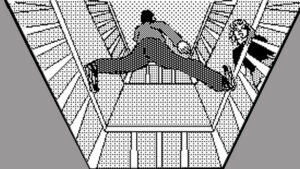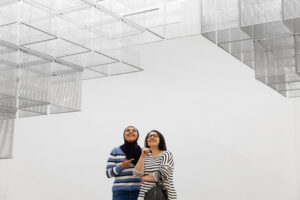
Slow Looking.

The Tate Gallery published an article saying take your time looking at art, complaining that people rush by the work without really looking. It seems that when people rush by a work, it’s not that the work is amazing, most likely it’s boring. A Museum of Modern Art curator has a youtube video telling us how to see Duchamp’s work. If we need to be told how to see an artist’s work, perhaps the artist’s message is unclear.
In 1996 (then MOMA curator) Rob Storr spoke of the transformation of the art world from the “Cedar Bar to the seminar”, which made art intellectual and discarded non-verbal syntax. That’s when Marshall McLuhan, in a quote often misattributed to Andy Warhol, said that art is anything that you can get away with. When art is anything you can get away with, then the worse you can get away with is always the best strategy, leading to some pretty bad art. Roger Scrutton said it is now an effective requirement of finalists for the Turner Prize in Britain to produce something that nobody would think was art unless they were told it was. At that point the artist’s message is strategically incomprehensible, but that’s terrible! I think we’re cornered, we can’t escape it; we need to define what good art is. Don’t be scared, it’s not that difficult.
I’m assuming a good work of art would attract our attention so we don’t have to be scolded into looking at it, and I’m hoping that good art makes a statement, so we don’t have to be told what to think about it. That’s a failure, when it’s not interesting… no matter how profound the marketing! Postmodern art is proudly difficult, counter-aesthetic, unattractive and undesirable; this thrills art experts, but are those people really experts or are they just brilliant mistakes?

According to William Deresiewicz’s article in the Atlantic, today’s art is not our highest achievement. It’s on show because the artist was a superb salesperson who fits snugly in the curator’s comfort zone. And that is why we need a reformation, some would even settle for a plain old-fashioned revolution.
Tate Gallery – A Guide to Slow Looking
An image like this
I was raised to scorn paintings like this; exciting art was supposed to be anti-aesthetic, unattractive, difficult, but my writing these days questions why. Seen in context, postmodernism may have nurtured the post-truth era: if art is prognostic, the future looks problematic. Can art change the course of history? Psychology speaks of art therapy, which suggests that the opposite, the counter-aesthetic, unattractive, and difficult, will likely cause mental illness and social disturbance.
Anyone who can paint like Parcellier knows about long hours, time, and effort, they’ve also experienced how one’s mind is expanded by the making. The level of analyses, the complex thinking generated changes the mind. The brain itself changes physically the more knowledge we acquire, folds develop and neural patterns expand.
 If you played Pokémon video games as a kid, part of your brain gets fired up when you see the characters. In a 2019 study, researchers from Stanford University showed test subjects hundreds of Pokémon characters. Pokémon fans reacted while those unfamiliar with the game, meh. But what’s more surprising is that a specific brain fold reacted, an area just behind the ears, called the occipitotemporal sulcus. We know that Einstein played violin, and like others who learn music as children, had an omega-shaped fold in the lower right at the back of the brain. In 1990 Neuroscientist Karl Friston developed an imaging technique that was used in a famous study to show that the rear side of the hippocampus of London taxi drivers grew in volume as they memorized maps when applying for a taxi license.
If you played Pokémon video games as a kid, part of your brain gets fired up when you see the characters. In a 2019 study, researchers from Stanford University showed test subjects hundreds of Pokémon characters. Pokémon fans reacted while those unfamiliar with the game, meh. But what’s more surprising is that a specific brain fold reacted, an area just behind the ears, called the occipitotemporal sulcus. We know that Einstein played violin, and like others who learn music as children, had an omega-shaped fold in the lower right at the back of the brain. In 1990 Neuroscientist Karl Friston developed an imaging technique that was used in a famous study to show that the rear side of the hippocampus of London taxi drivers grew in volume as they memorized maps when applying for a taxi license.
It would be fascinating to compare the visual cortex of an experienced artist with the population at large. It’s not that phrenology is making a comeback, but rather that data confirms knowledge resides in neural networks. The brain like the rest of the body is improved by practice, by repetition, by acquiring experience that turns into skill, knowledge, and mastery.
Today we understand painting and drawing as non-verbal visual languages, encoding complex ideas just as writing does. And since reading informs and transforms, so does non-verbal content embedded in an image. On a more spiritual level art sparks a greater subtlety and sophistication. When we see it we can’t look away. So if we are told that we need to pay attention to the art on exhibition, instead of casually walking by, then we can reply that we will, when the art deserves our attention.

I started reading “Boom” a book about the art world in NY since the late 50’s. There is something fortuitous about the way one person with money (the dealer) meets the artist and the rest is history. One gets the sense that it could have all turned out differently. I stopped reading it as this scenario gets repeated page after page. In order to find some foundations to abstraction I wrote this book: https://www.amazon.com/dp/1475021364
I think there is still much to learn from the great abstract painters. But the zombies just copy/paste.